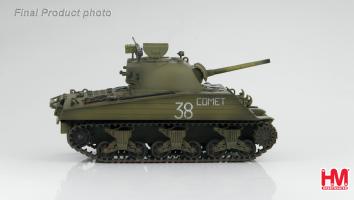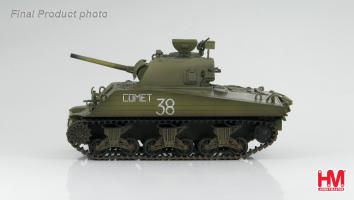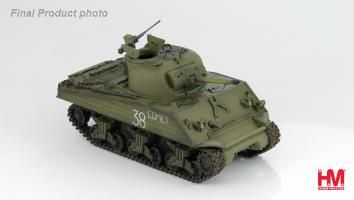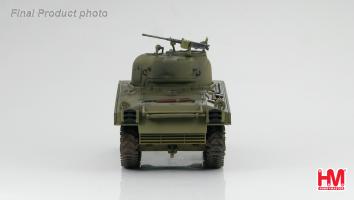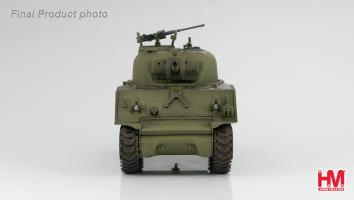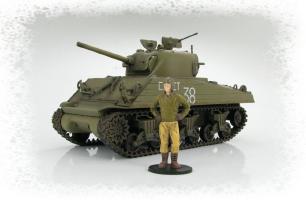Hobby Master Archive
Ground Power 1/48
Sherman
Ground power - M4A3 Sherman, 4th Marine Tank Battalion C Company, Widow Maker (Comet 38) Iwo Jima, February 1945
Because of the rugged dense jungle growth on many Pacific islands the use of tanks was limited. The tank did play significant roles on these islands as infantry support. The M4 had an escape hatch added to the floor but in the Pacific tank crews used it for the opposite purpose. They used the hatch to recover wounded infantry and return them for medical care. In the Pacific some units had many inventive means of trying to protect the tank and crew from the enemy. Some added track blocks to the sides of the turret, or on the glacis along with sand bags. Some added nails others added wooden planks or even heavy steel mesh domes placed over the hatches with about two inches of clearance. The domes were referred to as “bird cages” and along with the other innovations were meant to prevent the enemy from placing satchel charges directly on the tank especially the hatches that probably were the most vulnerable part of the armor. Some of the tank crews couldn’t decide one method so they employed just about all the various options. It was quite usual for tank crews to paint a name that started with the same letter as their Company on the side of the tank. That’s why there is Comet 38 on this particular example.
Known as the “Fighting Fourth” the 4th Marine Division was comprised of many units. One of the units was “C” Company of the 4th Marine Tank Battalion. The 4th Marine Division was formed on May 12, 1943 and was made up entirely of reservists except for 2 officers. It also was the first Marine Division to go directly in to battle and to capture territory held by occupying Japanese forces. The Division fought in some of the bloodiest battles of the Pacific, Kwajalein, Saipan, Tinian and Iwo Jima. The assault on Iwo Jima began on Feb 19 1945. The 4th Marine Tank Division “C” Company was attached to Combat Team 23 and their landings began at 0940 when LSMs delivered the first tanks on Yellow Beach. Because of the problems caused by the volcanic sand it wasn’t until 1300 before all the tanks were ashore. Landing on Iwo Jima was uncontested but when the beaches became congested with men and equipment that instantly sank in loose volcanic ash and became bogged down the Japanese defenders unleashed their big guns, mortars and snipers. The scene was one of carnage as men crawled along the shifting surface desperately trying to advance to the shelter of dunes or into shell holes made by the naval barrage that preceded the landing. During their time on Iwo Jima, Company “C” was attached to several Combat Teams whose main objectives were the areas around the two airfields on the island. Under the support of the tanks from the 4th MTB the Marines slowly worked their way towards their objectives. They encountered several long delays while engineers cleared mine-fields while under heavy fire. During their advance the tanks helped clear fortified caves and pill boxes and provided physical cover for the foot soldiers. The Japanese had definitely prepared for the invasion and intended to make the island their last stand with no surrender. On March 26, 1945 after five long bloody weeks Iwo Jima was finally cleared of enemy forces. The U.S. casualties totaled over 26,000 with over 7,000 dead while only 1,000 of the original 20,000 Japanese defenders survived. These sacrifices made it possible for B-29 bombers to make 2,400 unscheduled landings with 27,000 crewmen on their return flights from bombing mainland Japan. The 4th Marine Division was the first into action and they were the first to be sent back to the U.S. Where it was deactivated on November 28, 1945 and reactivated in 1966. For their actions in the Pacific Campaign the 4th Marine Division was awarded these medals and commendations:
4 Medals of Honor 111 Navy Cross 646 Silver Stars 2,517 Bronze Stars 17,722 Purple Hearts Presidential Unit Citation with 2 Bronze Stars Navy Unit Commendation Asiatic-Pacific Campaign Medal with 4 Bronze Stars WWII Victory Medal Of all the Medals of Honor that were awarded to Marines in WWII over 25% of them were because of their actions on Iwo Jima.
Specifications Manufactured by: Ford Motor Company Date first accepted: 1942 Total accepted then: 1,690 Crew: 5 - Commander, Gunner, Loader, Driver, Assistant Driver
Engine: Ford GAA 8 cylinder 4 cycle, 60° vee gasoline 450 hp @ 2600rpm Fuel capacity: 168 gallons Combat weight: 66,700 lbs Length: 232.5 " Width: 103" Height: 108"
Armament 1 X 75mm M3 main gun in turret - 97 rounds 1 X .30 cal MG coaxial to 75mm main gun - 4750 rounds 1 X .50 cal MG flexible in turret AA mount - 300 rounds 1 X .30 cal MG ball mount in right bow - 4750 rounds 2" Mortar M3 (smoke) fixed in turret - 12 rounds
Hobby Master 1/48 Ground Power Series HG1006 M4A3 Sherman, 4th Marine Tank Battalion “C” Company, “Widow Maker” (Comet 38) Iwo Jima, February 1945 LIMITED EDITION 500 pieces with COA
Authentic Detailing Pre-Painted by professionals Accurate paint colors Markings Tampo (pad) applied Fully Assembled Die-Cast Model True to Scale (1:48) Insignias Turret turns Main gun elevates Metal chassis, hull, turret and main gun Realistic tracks
| Added to archive | 2015-11-19 |
| Last modified | 2015-11-19 |
| Leaflet | 2009-03-01 March 2009 |
